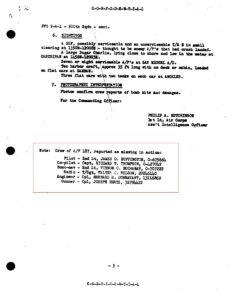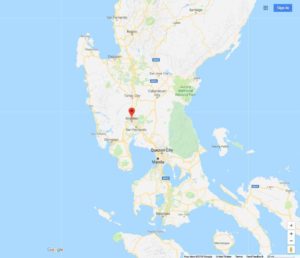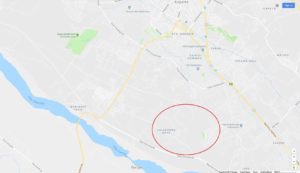Gadzooks, have six years gone by already? Updated on February 3, 2020, with an image of B-29 “Wugged Wascal”, I’ve (once again!) updated this post in this month of October, 2024. It now includes images of 1 Lt. Leonard Rifas, his crew, and the B-17 in which they were lost, “Miss D-day”. These images and related explanatory information were found at FindAGrave and Ancestry.. You can view them below.
* * * * *
Originally created on April 3, 2018, this post includes information about several casualties in the Army Air Force on January 9, 1945, among whom was Second Lieutenant Murray Karron, flight engineer on the B-29 “Wugged Wascal”. I’ve now updated the post to include two images of the “Wascal”, one from Steve Birdsall’s 1981 book Saga of the Superfortress, and another from Prentice Burkett’s The Unofficial History of the 499th Bomb Group (VH). These are the only images I’ve thus far found of this B-29 (42-24658).
Scroll down…
________________________________________
By its very nature, military activity – even when limited to action such as instruction and training; even when geographically distant from engagement with enemy forces in actual combat – has always entailed a solid element of risk and danger. One example of this appeared in The New York Times on February 15, 1945, through the publication of an obituary for Second Lieutenant George Greenfield (0-2070016), an Army Air Force navigator from the Bronx.
Killed in Bomber Crash Last Jan. 9 in England
 Lieut. George Greenfield, navigator on a B-24, was killed when his bomber crashed in England on Jan. 9, the War Department has notified his family here. Lieutenant Greenfield was 22 years old.
Lieut. George Greenfield, navigator on a B-24, was killed when his bomber crashed in England on Jan. 9, the War Department has notified his family here. Lieutenant Greenfield was 22 years old.
Born in this city, he was graduated from Stuyvesant High School in 1941 and then attended the University of Indiana for two years, majoring in languages. He enlisted two years ago and was qualified as a pilot in the Air Corps, but later was transferred and graduated as a navigator at Selman Field, La. He went overseas at the end of November.
His parents, Mr. and Mrs. Philip Greenfield of 1180 Anderson Avenue, the Bronx; a twin sister, Jeanette; and two other sisters, Mrs. Paul Bergman and Margaret Greenfield, survive.
This Google Street view image shows a contemporary (2014) view of 1180 Anderson Ave.
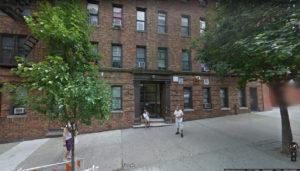 Though there’s no Missing Air Crew Report for Lt. Greenfield and his crew (his MACR index card carries the simple notation “No MACR”), his record at the American Battle Monuments Commission provides the “clue” by which the incident of January 9, 1945, can be identified: He was a member of the 706th Bomb Squadron of the 446th Bomb Group, with the Aviation Archeology database revealing that a B-24H Liberator of that squadron (42-95306, “RT * S”, nicknamed “Dragon Lady” and piloted by 2 Lt. Andrew J. Puschock, Jr.) was lost in an accident at Whittlesford, England on that date.
Though there’s no Missing Air Crew Report for Lt. Greenfield and his crew (his MACR index card carries the simple notation “No MACR”), his record at the American Battle Monuments Commission provides the “clue” by which the incident of January 9, 1945, can be identified: He was a member of the 706th Bomb Squadron of the 446th Bomb Group, with the Aviation Archeology database revealing that a B-24H Liberator of that squadron (42-95306, “RT * S”, nicknamed “Dragon Lady” and piloted by 2 Lt. Andrew J. Puschock, Jr.) was lost in an accident at Whittlesford, England on that date.
Though the records of the 706th Bomb Squadron, and, any Accident Report filed after the incident would certainly list the plane’s crew, only limited information is currently available about the other casualties in this incident. Aside from Lt. Puschock, who is buried at Arlington National Cemetery, another fatality is known to have been 2 Lt. Robert Wallace Allen, presumably the bomber’s co-pilot, who is buried at the Cambridge American Cemetery, in Cambridge, England (Plot B, Row 5, Grave 54).
Lieutenant Greenfield’s name appeared in the “In Memoriam” section of The New York Times on December 1, 1945. Born on December 1, 1922, his name appears on page 335 of American Jews in World War II. His sole award is the Purple Heart, suggesting that the Puschock crew – perhaps a newly arrived crew, as implied by his November arrival in England – may have flown fewer than five combat missions prior to the accident on January 9. He is buried in the Cambridge American Cemetery, near Lt. Allen, at Plot B, Row 6, Grave 54. His matzeva, photographed by Skip Farrow, is show below:
 Another aspect of this news item is more subtle, almost “hiding in plain sight”: The single-bladed propeller on Lt. Greenfield’s cap was the emblem of World War Two Army Air Force aviation cadets, suggesting that his portrait (a very good portrait) was an image in his family’s possession which was donated to the Times.
Another aspect of this news item is more subtle, almost “hiding in plain sight”: The single-bladed propeller on Lt. Greenfield’s cap was the emblem of World War Two Army Air Force aviation cadets, suggesting that his portrait (a very good portrait) was an image in his family’s possession which was donated to the Times.
Some other Jewish military casualties on Tuesday, January 9, 1945, include…
Killed in Action
– .ת.נ.צ.ב.ה. –
Boyaner, Frank, Major
Canadian Dental Corps
Mrs. Hazel Olive Boyaner (wife)
Mr. and Mrs. Don and Kaylia Boyaner (parents)
Born Saint John’s, New Brunswick, Canada, 3/23/25
Brookwood Military Cemetery, Surrey, England – 56,D,9
Canadian Jews in World War II – Part II: Casualties – 12
Carp, Paul Iban, Lt. JG, 0-184815, Purple Heart
United States Navy
Possibly lost while serving as a member of a liaison team aboard a French escort vessel
Mr. Joseph Shepard Carp (father), 2738 SW 20th St., Miami, Fl.
Miss Clare Schwartz and Mrs. Ruth C. Rosow (sisters)
Graduate of Harvard University
Tablets of the Missing at North African American Cemetery, Carthage, Tunisia
WW II Memorial Honoree Record by Ruth C. Rosow (sister)
Jewish Floridian 3/2/45
American Jews in World War II – 82
______________________________
Cohen, Clarence, Cpl., 36895289, Gunner (Central Fire Control), Air Medal, Purple Heart, 2 missions
United States Army Air Force, 20th Air Force, 500th Bomb Group, 883rd Bomb Squadron
Mrs. Bettie (Nettie?) Romanoff (sister), 7454 Wykes St., Detroit, Mi.
Also 693 Alabama Ave., Brooklyn, 7, N.Y.
MACR 10903; Aircraft: B-29 42-24657 (“Mustn’t Touch”; “Z square 45”), Pilot: Capt. John J. Charters; 11 crewmen
Aircraft presumably ditched; no survivors
Corporal Cohen’s Superfortress, Mustn’t Touch, was lost during a mission to the Musashino Aircraft Works and Nakajima Aircraft Engine Factory near Tokyo. There is little (and will forever be little) definitive information about the plane’s loss, seemingly attributable to mechanical problems with the plane’s engines necessitating ditching in the Pacific Ocean roughly half-way between Saipan and Japan. As summarized in Missing Air Crew Report 10903:
Shortly after take-off, his aircraft developed mechanical problems. During climb-out the #1 engine was leaking oil, and puffs of black smoke were coming from the #4 engine. At 16,000 feet his aircraft feathered the #1 engine propeller and began to abort the sortie. Last visual contact was at a geographic location of 28 degrees 10 minutes north and 137 degrees 30 minutes east, at 0315Z. Last radio contact, at 0410Z, stated they had lost an engine and were going to ditch in the ocean, approximately 900 nautical miles north of Saipan. No survivors were ever found, and he was declared killed in action one year later.
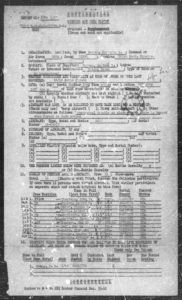 Corporal Cohen and his fellow crewmen are memorialized on the Tablets of the Missing at the Honolulu Memorial, in Honolulu. His name appears on page 290 of American Jews in World War II.
Corporal Cohen and his fellow crewmen are memorialized on the Tablets of the Missing at the Honolulu Memorial, in Honolulu. His name appears on page 290 of American Jews in World War II.
This below image of the nose art of Mustn’t Touch is from Tom McNamara’s flickr photostream, while the second image – Army Air Force photograph 64276AC / A39219 – taken on Saipan in November, 1944, shows the aircraft before the application of nose art. (The soldiers in the foreground, from an engineer battalion, are drilling holes for dynamite charges during construction of an airstrip at Isley Field.) Of technical interest, the image clearly shows the tail cannon characteristic of early B-29s, which weapon would eventually be deleted from the Superfortress due to its slow rate of fire, and, the difference between the trajectories of its 20mm shells, and, those of the twin tail-mounted co-axial 50 caliber Browning machine guns.
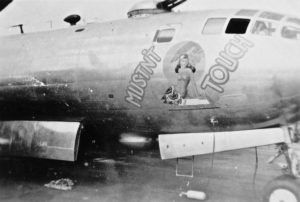
 ______________________________
______________________________
Cohen, Louis, PFC, 39558749
United States Army Air Force, 77th Air Service Group, Headquarters Squadron
Died (non-battle) on Tinian Island
Mrs. Betty G. Cohen (wife), 1318 S. Cochran Ave., Los Angeles, Ca.
Born 1911
No number on MACR index name card
National Memorial Cemetery of the Pacific, Honolulu, Hawaii – Section Q, Grave 662
American Jews in World War II – 41
Frenkel, Boris Mikhailovich (Френкель, Борис Михаилович) Senior Sergeant [Старший Сержант]
U.S.S.R., Red Army, 63rd Cavalry Division
Radio Operator in Valentine Mk IX tank
Born 1925
Probably buried at Zámoly Village, Fejér County, Hungary
Memorial Book of Jewish Soldiers Who Died in Battles Against Nazism – 1941-1945 – Volume IX – 307 [Книги Памяти евреев–воинов, павших в боях с нацизхмом в 1941-1945 гг – Том IX – 307]
______________________________
Hertz, Joseph, Cpl., 32794422, Tail Gunner, Air Medal, Purple Heart
United States Army Air Force, 5th Air Force, 345th (“Air Apaches”) Bomb Group, 500th Bomb Squadron
Mr. and Mrs. Haney and Selma L. Hertz (parents), Arnold (brother), 120 Hopkins St., Brooklyn, N.Y.
Born Austria, 1920
MACR 16290; Aircraft: B-25J 43-36187 (“Man of War”, or, “Man-O-War”); Pilot: 2 Lt. James O. Buffington, and five crew members
Man-O-War was struck by anti-aircraft fire during bombing and strafing mission over Luzon, crash-landing south of the city of Angeles.
Cpl. Hertz, Lt. Buffington (Peru, Indiana), and, Bombardier / Navigator 2 Lt. Vernon C. Buchanan (Indianapolis) were killed in the immediate crash of the aircraft, while three crew members survived the loss of the plane. The latter were Co-pilot Capt. Richard T. Thompson (Delta, Michigan), Flight Engineer Cpl. Bernard R. Dunnavant (Victoria, Virginia), and Radio Operator T/Sgt. Walter J. Nelson (Union City, N.J.)
Thompson and Dunnavant, both very seriously injured and unable to move, remained at the site of the wrecked plane. T/Sgt. Nelson, less seriously hurt, aided them to the best of his ability, and then attempted to reach Filipino civilians for further help.
During his absence, Japanese troops arrived at the scene of the wreck and murdered his surviving comrades.
Concealed by Filipino civilians from discovery by the Japanese – in the village of Delores Mabalacat – Sgt. Nelson was turned over to a band of Filipino guerillas, and, eventually joined by Sgt. Nolan W. Huddleston of the 387th Bomb Squadron, 312th Bomb Group, returned to American forces by January 23.
The five casualties from Man-O-War are are listed as having been awarded the Air Medal and Purple Heart, with Lt. Buffington having received two Oak Leaf Clusters, suggesting that they had flown between five and ten combat missions prior to January 9. They are listed on the Tablets of the Missing at the Manila American at Fort Bonifacio, Manila.
FindAGrave includes a record for WW II Army Air Force veteran “Walter John Nelson”, who died in 2013 and is buried at the Brigadier General William C. Doyle Veterans Memorial Cemetery in Wrightstown, New Jersey. This biographical record seems (?) to “fit” information about T/Sgt. Nelson of Man-O-War, with the exception that the record is for a Corporal – and not T/Sgt. – Nelson.
The 500th Bomb Squadron Mission Report for the 9 January mission (extracted from the 500th Bomb Squadron’s Mission Reports encompassing August 1944 through August 1945, at the 345th Bomb Group) is shown below, with sections pertaining to the loss of Man-O-War outlined in red. This is followed by a series of Google Maps showing – at successively larger scales – the probable area (as denoted by the red oval) where Man-O-War crash-landed. This location was identified through information in Lawrence Hickey’s Warpath Across the Pacific, MACR 16290, and a map of Clark Field and Vicinity, at Pacific Wrecks.
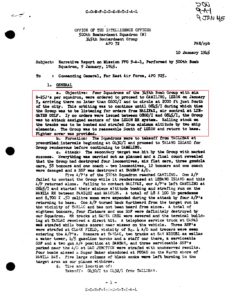 Mission Objective; Mission Description.
Mission Objective; Mission Description.
______________________________
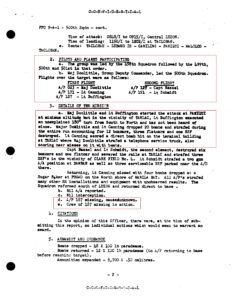 Details of the Mission: “Lt. Buffington executed an unexplained 180 turn from South to North and has not been heard of since.”
Details of the Mission: “Lt. Buffington executed an unexplained 180 turn from South to North and has not been heard of since.”
But, as recounted in Warpath Across the Pacific…
“Eight miles below Tarlac, 2 Lt. James O. Buffington pulled his plane from a loose formation and doubled back to hit a pair of trucks bypassed on the adjacent highway. Minutes later, hastening to catch up with his flight, Buffington and his co-pilot, Capt. Richard T. Thompson, saw two trucks sitting on the tracks just north of Dau Junction. Their initial attack was made from fifty feet and left three box cars blazing. But as they pulled off their run, a flak battery found thee range.
T/Sgt. Walter J. Nelson was in the radio compartment when the plane jerked suddenly. Glancing forward, he saw a fire blazing in the cockpit. “This is it. We’re going down!” his mind screamed at him. Only seconds separated Nelson from possible death and he used them well. He released the emergency escape hatch, then braced himself against the transmitter, using a parachute for a head cushion. The plane jarred violently as the belly furrowed a rice paddy. A low earthen mound ripped off a wing and spun the plane into a tight loop, pitching Nelson through the open hatch.
When he awoke, the radio operator found himself on the ground next to the burning aircraft. Near the right nacelle lay Cpl. Bernard Dunnavant, the turret gunner, with one leg almost severed. Five hundred yards away sat two camouflaged bombers bearing the blood-red Japanese hinomaru on their fuselages. The ill-fated crew had come to grief on the very edge of Angeles South, one of the satellite airfields in the Clark Field complex.”
______________________________
The crew of Man-O-War.
______________________________
______________________________
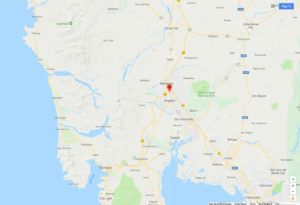 Luzon, with Angeles and Mabalacat in the center of the map.
Luzon, with Angeles and Mabalacat in the center of the map.
______________________________
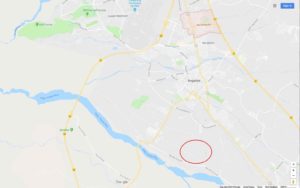 The possible – general – crash location of Man-O-War: South of Angeles.
The possible – general – crash location of Man-O-War: South of Angeles.
______________________________
A closer view of the possible crash site: An area bounded by the Angeles-Porac-Floridablanca-Dinaluphin Road (to the west), the Pasig-Potrero River (to the south), and MacArthur Highway / Manila North Road (to the east).
______________________________
Ioffe, Abel Abramovich [Иоффе, Абель Абрамович] (at Priekule, Latvia)
16th Lithuanian Rifle Division, 156th Rifle Brigade
Mr. Avraham Yofe (father)
Born 1922
Probably buried at Kuldiga County, Latvia
Road to Victory – 281 (Name given as Yofe, Abel, Sgt.)
______________________________
Karron, Murray, 2 Lt., 0-868393, Flight Engineer, Air Medal, Purple Heart
United States Army Air Force, 20th Air Force, 499th Bomb Group, 877th Bomb Squadron
Mrs. Alyse (Cohen) Karron (wife), 1163 East 27th St., Brooklyn, N.Y.
Mr. and Mrs. Louis and Tillie [11/10/53] Karron (parents); Evelyn and Jack (siblings)
MACR: 10911; Aircraft: B-29 42-24658 (“Wugged Wascal”; “V square 3”) Pilot: Capt. Kimmel Parker Murphy; 11 crewmen
Aircraft presumably ditched; no survivors
Brooklyn Eagle 1/16/42
American Jews in World War II – 357
New York Times Obituary “In Memoriam” Section – 11/12/53

I’ve not been able to find a photograph of Murray Karron, but this is an image (not the best, but still it’s an image) of Murray’s fiancee and future wife, Alyce (Alyse?) Cohen, as published in the Brooklyn Eagle on January 16, 1942.
________________________________________
The loss of Lt. Karron’s crew in Wugged Wascal, piloted by Captain Kimmel Murphy, parallels that of Corporal Cohen’s: Target: Musashino Aircraft Works and Nakajima Aircraft Engine Factory. Reason for loss: “Operational difficulties”. Action: Ditching. Result: No survivors.
Oddly, the Missing Air Crew Report for Captain Murphy’s plane – lost after successfully completing its bombing-run – contains no statement specifically describing what actually befell the aircraft. Instead, information about the missing bomber is found in a document dated January 10, 1946 within MACR 10907, which covers the losses of six B-29s (recorded in MACRs 10903, 10904, 10907 itself, 10908, 10911, and 11220) from the mission of January 9, 1945.

 The statement covering 42-24658 is as brief as it is enigmatic, simply stating:
The statement covering 42-24658 is as brief as it is enigmatic, simply stating:
The plane was last contacted by radio at 0908Z by Sergeant Irving R. Wirth, at 25-30 N, 146-30E. The report states that the aircraft is believed to have been ditched in the ocean as a result of operational difficulties [nature unspecified].
The coordinates 25-30 N – 146-30 E mark a location about 250 miles east of Iwo Jima, Volcano Isles.
Another statement notes the search for the missing crew:
Search started 1000 K 10 Jan 1945, to be continued until darkness or limited endurance of aircraft. Search will continue on subsequent days for as long as the 73rd Bomb Wing permits.
Like Corporal Cohen, Lt. Karron and his fellow crewmen are memorialized on the Tablets of the Missing at the Honolulu Memorial, in Honolulu. As for 2 Lt. Jack M. Danowitz (mentioned in the blog post covering 1 Lt. Arthur S. Goldstein), Major David I. Cedarbaum preserved a record (recorded by W.D. Bray) about Lt. Karron’s last flight – actually, far more informative than the MACR, albeit with the plane’s final location being incorrect – to which nothing further could ever be added:
 The Airplane Commander was K.P. Murphy. They flew to the Jap homeland, dropped their bombs, and an hour away began to have engine trouble. They radioed the fire spread and they had to ditch, the plane being out of control. They were about 100 miles north of Iwo presumably when they hit the water. No rescue facility was ever able to locate anything of them.
The Airplane Commander was K.P. Murphy. They flew to the Jap homeland, dropped their bombs, and an hour away began to have engine trouble. They radioed the fire spread and they had to ditch, the plane being out of control. They were about 100 miles north of Iwo presumably when they hit the water. No rescue facility was ever able to locate anything of them.
________________________________________
 From The Unofficial History of the 499th Bomb Group (VH), this picture shows the crew of Prentice Burkett standing before “Wugged Wascal”. Unfortunately, like all crew photos in the book, the men’s names are not given, but the five men standing at rear are likely Burkett and the crew’s other officers, while the six men in front are presumably NCOs.
From The Unofficial History of the 499th Bomb Group (VH), this picture shows the crew of Prentice Burkett standing before “Wugged Wascal”. Unfortunately, like all crew photos in the book, the men’s names are not given, but the five men standing at rear are likely Burkett and the crew’s other officers, while the six men in front are presumably NCOs.
________________________________________
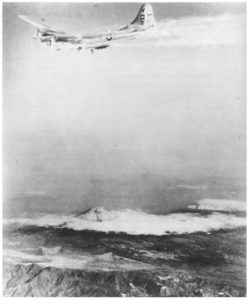 Printed as a full-page image on page 138 of Steve Birdsall’s Saga of the Superfortress, this photograph, from the collection of Lawrence F. Reineke, is captioned, “The 499th Group’s Wugged Wascal near Fuji on January 9, with Captain Kimmel Murphy and his crew. A few hours after this photo was taken she crashed into the sea, less than seven hundred miles from Saipan.” This image also appears (in smaller size) in The Unofficial History of the 499th Bomb Group (VH).
Printed as a full-page image on page 138 of Steve Birdsall’s Saga of the Superfortress, this photograph, from the collection of Lawrence F. Reineke, is captioned, “The 499th Group’s Wugged Wascal near Fuji on January 9, with Captain Kimmel Murphy and his crew. A few hours after this photo was taken she crashed into the sea, less than seven hundred miles from Saipan.” This image also appears (in smaller size) in The Unofficial History of the 499th Bomb Group (VH).
______________________________
 This is a very-high-resolution (600 dpi) scan of the “Wascal”, as seen in the above image. Even at this magnification the clarity of the image is remarkable, with structural details and the last four digits of the B-29’s serial clearly visible. More important, of course, are the eleven men inside the plane..
This is a very-high-resolution (600 dpi) scan of the “Wascal”, as seen in the above image. Even at this magnification the clarity of the image is remarkable, with structural details and the last four digits of the B-29’s serial clearly visible. More important, of course, are the eleven men inside the plane..
______________________________
Katz, Wolf, Sgt. (at Ginkunai, Lita)
U.S.S.R., Red Army, 16th Lithuanian Rifle Division, 224th Artillery Brigade
Mr. Chone Katz (father)
Place of burial unknown
Road to Victory – 290
Mirvis, Mikhail Borisovich (Мирвис, Михаил Борисович) Private [Рядовой]
U.S.S.R., Red Army, 58th Rifle Division, 20th Tank Brigade, 45th Autonomous Motor Rifle Battalion
Rifleman
Died of wounds at Medical Facility of 45th Medical Battalion, 53rd Rifle Division
Born 1924
Buried at Cemetery Number 80, Grave 1, Muzhla Village, Komarom-Estergom, Hungary
Memorial Book of Jewish Soldiers Who Died in Battles Against Nazism – 1941-1945 – Volume II – 547 [Книги Памяти евреев-воинов, павших в боях с нацизхмом в 1941-1945 гг – Том II – 547]
Ples, Josef, WO 2C, W-336 (at Dunkirk, France)
Czechoslovakia, 1st Czechoslovak Army Corps, 1st Armored Brigade
Czechoslovakia, Lipník nad Bečvou, okres Přerov; 8/12/19
Cassel Communal Cemetery Extension, Nord, France – D,15
Zide v Ceskoslovenskem Vojsku na Zapade – 247
______________________________
Rifas, Leonard, 1 Lt., 0-771802, Bomber Pilot, Air Medal, 4 Oak Leaf Clusters, Purple Heart, 27 missions
United States Army Air Force, 8th Air Force, 385th Bomb Group, 549th Bomb Squadron
Born Chicago, Il., December 20, 1921
Mrs. Jeanette Rosalie (Rifas) Miller (sister) (12/21/14-7/21/04)
5125 N. Capitol St., Washington, D.C.
Mr. and Mrs. Samuel Leo (1/15/88-1951) and Sarah Rieva (Kulvinsky) (3/21/90-3/85) Rifas (parents) Bertram E. “Bert” Rifas (brother) (10/27/24-11/12/11)
1216 Broadway, c/o Commonwealth, Kansas City, Mo.
Aircraft: B-17G 44-6100 (“Miss D-day”) 10 crewmen – no survivors
MACR 11718
Tablets of the Missing at Cambridge American Cemetery, Cambridge, England
American Jews in World War II – 113
Half-way ‘round the world from the loss of Mustn’t Touch and Wugged Wascal, another bomber – 8th Air Force Flying Fortress Miss D-day, piloted by Lieutenant Leonard Rifas – was lost in circumstances as enigmatic as those two bombers: The aircraft vanished during a short flight from an emergency landing strip in France, to the 385th Bomb Group’s base at Great Ashfield, England. Though the bodies of two crewmen were found by Air/Sea Rescue, the other eight crewmen remained (still remain) missing. There were no survivors.
As stated in Missing Air Crew Report 11718: Aircraft 44-6100, returning from operational mission to Frankfurt, Germany on 8 January 1945, landed at emergency landing strip, A-70, Laon-Couvron, France. Radio message was received at station 155, that this aircraft had been given clearance on the afternoon of 9 January 1945, but due to weather conditions on the continent it was believed that clearance had been cancelled, as no further contact was made by either A-70 or station 155.
The bodies of two of the crew frozen together in a life raft [2 Lt. John W. Skoff, bombardier, and S/Sgt. Lowey I. Boyd, ball turret gunner] were picked up at 50 – 40 N, 00 – 20 E, 13 January 1945, by Air/Sea Rescue and taken to New Haven Mortuary. [New Haven is located just east of Brighton, in southern England.]
Here’s Leonard Rifas’ graduation portrait from the 1921 yearbook of Chicago’s Woodrow Wilson Junior College.
Initially found at FindAGrave, where it was uploaded by Carolyn DeLoach, this image of Lt. Rifas and his crew was originally uploaded to Ancestry.com by “kochwayne” on January 18, 2014. The original source of this halftone photo is unknown.
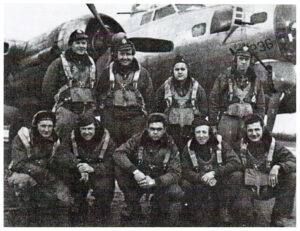 “kochwayne” also added a smaller photo to Ancestry to serve as a name key to the crew portrait. Using that image as a guide and correlating the names thereupon to those listed in MACR 11817 yields the following list. Note that ball turret gunner Lowey Boyd is apparently absent from the photo.
“kochwayne” also added a smaller photo to Ancestry to serve as a name key to the crew portrait. Using that image as a guide and correlating the names thereupon to those listed in MACR 11817 yields the following list. Note that ball turret gunner Lowey Boyd is apparently absent from the photo.
Rear
Pilot – Leonard Rifas, 1 Lt., 0-771802, Washington, D.C.
Co-Pilot – Charles M. Jones, 2 Lt., 0-1997859, Cincinnati, Oh.
(? – Navigator – Robert G. Chandler, 2 Lt., 0-1997897, Framingham, Ma.)
(? – Bombardier – John W. Skoff, 2 Lt., 0-717902, Joliet, Il.)
Front
Gunner (waist) – Dwain R. Rasmussen, S/Sgt., 37266500, Cotesfield, Ne.
Gunner (waist) – John H. Parrish, S/Sgt., 36860139, Alma, Mi.
Flight Engineer – William D. Finkbiner, T/Sgt., 36368254, Palestine, Il.
Radio Operator – Wilmer W. Sherwood, T/Sgt., 16019735, Charleston, Il.
Gunner (tail) – Alphonse J. Novetske, S/Sgt., 36893952, Detroit, Mi.
Not in photo?…
Gunner (Ball Turret) – Lowey I. Boyd, S/Sgt., 33657419, Davenport, Va.
Here’s a nice close-up of the bomber’s nose art. Unfortunately, its individual squadron identification letter is unknown. The 549th Bomb Squadron history in AFHRA microfilm roll A0641 is strikingly anemic, only very briefly mentioning the plane’s loss on frames 391 and 392.
What happened aboard Miss D-day will never be known, but based on information in the MACR, no emergency calls were radioed from the aircraft during its brief flight, or if they were, such signals were not received. The fact that the bombardier (from the front of the aircraft) and ball turret gunner (from the plane’s aft fuselage) survived for a time in one of the plane’s two rafts, suggests that there may have been adequate time for the crew to at least gather in the radio room for a controlled ditching, probably somewhere between Boulgone, France, and Beachy Head, England. Though Lt. Skoff and S/Sgt. Boyd were found roughly – only – fifteen miles south of Eastbourne, in the English Channel (the location designated by the red circle in the below map), in mid-winter, in an open raft, those fifteen miles might just as well have been one thousand…
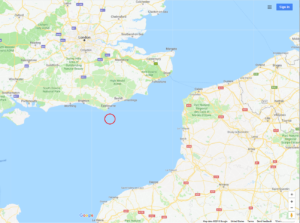 Lt. Skoff, from Will County, Illinois, is buried at Camp Butler National Cemetery, Springfield, Il. (Section 4, Grave 26), while Sergeant Boyd, from Buchanan County, Virginia, is buried at the Cambridge American Cemetery, in Cambridge, England (Plot F, Row 6, Grave 110).
Lt. Skoff, from Will County, Illinois, is buried at Camp Butler National Cemetery, Springfield, Il. (Section 4, Grave 26), while Sergeant Boyd, from Buchanan County, Virginia, is buried at the Cambridge American Cemetery, in Cambridge, England (Plot F, Row 6, Grave 110).
According to records at the 385th Bomb Group, Lieutenant Rifas completed 27 missions. For his first twelve missions, he served as co-pilot to Ted C. Findeiss. Commencing with the Hannover mission of October 26, 1944 he served as pilot, with nine of his fifteen missions in this capacity being flown in Miss D Day.
______________________________
Rosenberg, Jacob Joseph, EM3c, 2425767, Electrician’s Mate, Purple Heart
United States Navy, USS John D. Henley (DD553)
“0821: Two men [EM3c Jacob J. Rosenberg and F1c Kenneth Dowd Russell] fell overboard and were not recovered after a thorough search of the area.” (11-34 N, 159-14 E)
Mrs. Sophia Anna (Rosenberg) Zitzer (sister), 16 Greenock St., Boston, Ma.
Tablets of the Missing at Honolulu Memorial, Honolulu, Hawaii
American Jews in World War II – 176
Rubin, Harold, S 2C, 8625065, Seaman, Purple Heart
United States Navy, USS Mississippi
Mr. Able Rubin (father), 1659 W. Euclid Ave., Detroit, Mi.
Tablets of the Missing at Manila American Cemetery, Manila, Philippines
American Jews in World War II – 195
References
Birdsall, Steve, Saga of the Superfortress, Sidgwick & Jackson, London, England, 1981
Burkett, Prentiss M., Capt., The Unofficial History of the 499th Bomb Group (VH), Historical Aviation Album, Temple City, Ca., 1981
Dublin, Louis I., and Kohs, Samuel C., American Jews in World War II – The Story of 550,000 Fighters for Freedom, The Dial Press, New York, N.Y., 1947
Hickey, Lawrence J., Warpath Across the Pacific – The Illustrated History of the 345th Bombardment Group During World War II, International Research and Publishing Corporation, Boulder, Co., 1984
Leivers, Dorothy (Editing and Revisions), Road to Victory – Jewish Soldiers of the 16th Lithuanian Division, 1941-1945, Avotaynu, Bergenfield, N.J., 2009
Kulka, Erich, Zide Československém Vojsku na Západé, Naše Vojsko, Praha, Czechoslovakia, 1992
Loyd, Alwyn T., B-29 Superfortress in detail & scale – Production Version – Part 1, Aero Publishers, Inc., Fallbrook, Ca., 1983.
Sturzbecker, Russell L., The Roarin’ 20s: A History of the 312th Bombardment Group, U.S. Army Air Force – World War II, Russell L. Sturzbecker, Westchester, Pa., 1976
Canadian Jews in World War II – Part II: Casualties, Canadian Jewish Congress, Montreal, Quebec, Canada, 1948
Memorial Book of Jewish Soldiers Who Died in Battles Against Nazism – 1941-1945 – Volume II [Surnames beginning with К (K), Л (L), М (M), Н (N)], Maryanovskiy, M.F., Pivovarova, N.A., Sobol, I.S. (editors), Union of Jewish War Invalids and Veterans, Moscow, Russia, 1995
Memorial Book of Jewish Soldiers Who Died in Battles Against Nazism – 1941-1945 – Volume IX [Surnames beginning with all letters of the alphabet], Maryanovskiy, M.F., Pivovarova, N.A., Sobol, I.S. (editors), Union of Jewish War Invalids and Veterans, Moscow, Russia, 2006
B-29 42-24657 (Tom McNamara photostream, at flickr.com)
2/3/20 – 889

